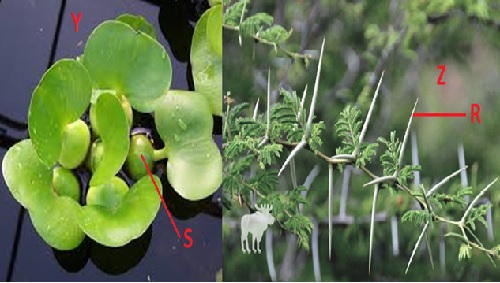Question 1
You are provided with Specimen K .Carefully cut a transverse section through specimen K using a scalpel provided
a) (i) By observing one of the two halves of specimen K, Give two reasons to prove that specimen K has axile placentation
(ii) Squeeze some juice from specimen K into 100ml beaker provided and label it as juice K. Using a portion of juice K, carry out the food test using the reagents provided and complete the table below.
(NB preserve the remaining portion of juice K for use in question 2 )
| Food substance | Procedure | Observation | Conclusion |
|---|---|---|---|
(iv) Highlight two symptoms of the disease named in (a) (iii) above
b) Put 2cm3 of liquid labeled C into a test tube. Draw some of the juice from specimen K into a dropper. Add 4 drops of the juice into the test tube with solution C and shake.
(i) State your observation
(ii) State the part of the human body where the process demonstrated above occurs and the enzyme that carries out the process.
Part of body
Enzyme
(iii) Which gland produces the enzyme stated in (a) (ii) above?
Answer
a) (i) - Edges of the carpels fuse together to form a central placenta
- Ovary wall divides into multiple loculi/chambers
(ii) Squeeze some juice from specimen K into 100ml beaker provided and label it as juice K. Using a portion of juice K, carry out the food test using the reagents provided and complete the table below.
(NB preserve the remaining portion of juice K for use in question 2 )
(iii) Scurvy
(iv) 1. Bleeding gums
2. Poor healing of wounds
b) (i) liquid C forms a solid particles / liquid C curdles
(ii) Part of body - Stomach
Enzyme - Rennin
(iii) Gastric gland
- Ovary wall divides into multiple loculi/chambers
(ii) Squeeze some juice from specimen K into 100ml beaker provided and label it as juice K. Using a portion of juice K, carry out the food test using the reagents provided and complete the table below.
(NB preserve the remaining portion of juice K for use in question 2 )
| Food substance | Procedure | Observation | Conclusion |
|---|---|---|---|
| Starch | To a little amount of juice K in a test tube add two drops of iodine solution | Brown color of iodine solution remains/persist | Starch absent |
| Vitamin C | To a little amount of DCPIP in a test tube, add juice K drop wise as you shake | DCPIP decolorizes | Vitamin C present |
(iv) 1. Bleeding gums
2. Poor healing of wounds
b) (i) liquid C forms a solid particles / liquid C curdles
(ii) Part of body - Stomach
Enzyme - Rennin
(iii) Gastric gland
Question 2
a) Take a small amount of substance B provided and add to it 2cm3 of sodium hydrogen carbonate solution.
(i) State your observations
(ii) Which process in the body is illustrated above?
(iii) State the part of the body where the above process takes place
(iv) State two functions of substance B in the body
(v) Name two diseases of the circulatory system caused by excess cholesterol in food.
b) Study the photographs below depicting plants growing in different habitats. Use them to answer the questions that follow.

(i) Identify the habitats in which they are found
Y
Z
(ii) State the significance of the following structures found in the specimens shown above.
R
S
Answer
a)
(i) Broken down into small droplets
(ii) Emulsification
(iii) Duodenum
(iv) 1. Oxidized to release energy
2. Shock absobers on vital organs
(v) 1. Artheriosclerosis
2. Thrombosis;
b) (i) Y - Aquatic/fresh water
Z - Teresterial
(ii) R - Minimizes rate of water loss / defense against browsers
S - Store air for buoyancy
(ii) Emulsification
(iii) Duodenum
(iv) 1. Oxidized to release energy
2. Shock absobers on vital organs
(v) 1. Artheriosclerosis
2. Thrombosis;
b) (i) Y - Aquatic/fresh water
Z - Teresterial
(ii) R - Minimizes rate of water loss / defense against browsers
S - Store air for buoyancy
